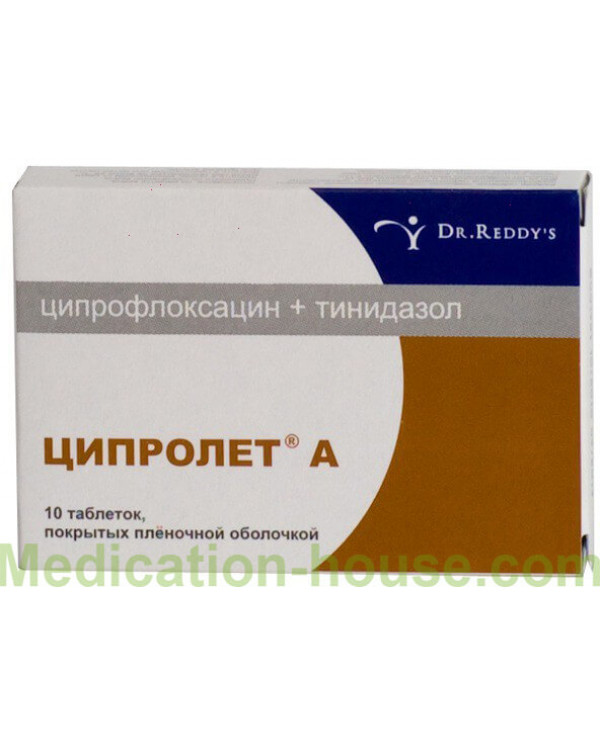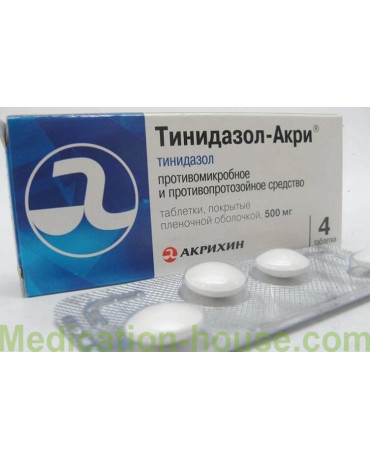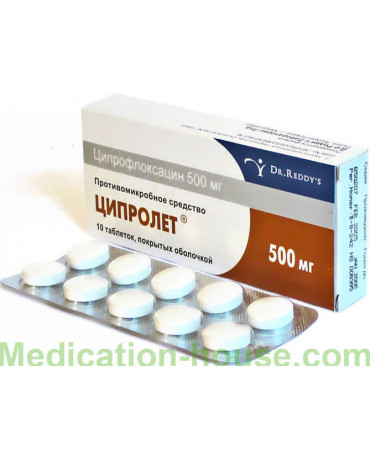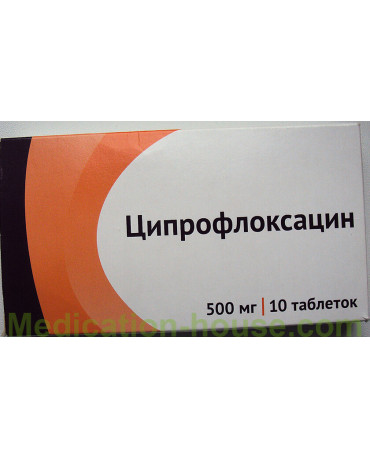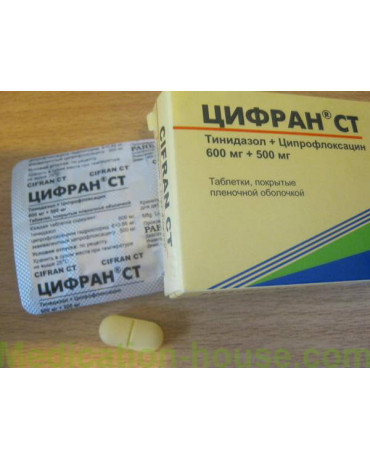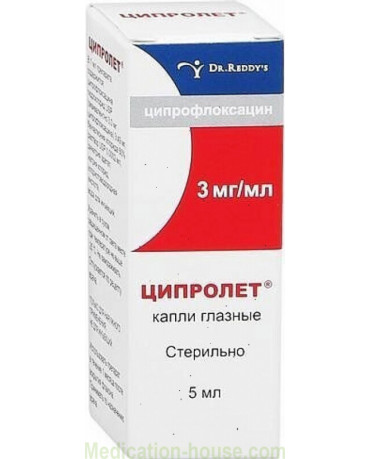Ciprolet A instruction
You can buy Ciprolet A here
DOSAGE FORM, COMPOSITION AND PACKAGING
Tablets, film coated light orange or orange color with numerous small patches of darker, oval in shape, with dividing risk on one side and smooth on the other.
1 tab.
ciprofloxacin hydrochloride monohydrate 582.285 mg
which corresponds to the content of ciprofloxacin 500 mg
tinidazole 600 mg
Excipients: corn starch - 35 mg, croscarmellose sodium - 27.476 mg, microcrystalline cellulose - 5 mg, sodium carboxymethyl starch (type A) - 5 mg, colloidal silicon dioxide - 3.952 mg, talc - 8.952 mg, magnesium stearate - 7 mg.
The composition of the shell: hypromellose (6 cps) - 21.21 mg, sorbic acid - 209.5 µg, titanium dioxide - 1 mg, talc - 4.01 mg, macrogol 6000 - 4.01 mg, polysorbate 80 - 209.5 µg, dimethicone - 295 µg, dye sun-setting yellow (E110) - 9.047 mg.
10 pieces. - blisters (1) - packs cardboard.
PHARMACHOLOGIC EFFECT
Combined medication, the action of which is due to the components in its composition.
Ciprofloxacin - a broad-spectrum antimicrobial agent, a fluoroquinolone derivative, inhibits bacterial DNA gyrase (topoisomerases II and IV, which are responsible for the supercoiling of chromosomal DNA around nuclear RNA, which is necessary for reading genetic information), violates the synthesis of DNA, the growth and division of bacteria; causes pronounced morphological changes (including cell walls and membranes) and the rapid death of the bacterial cell.
It acts bactericidal on Gram-negative organisms in the period of rest and division (since it affects not only the DNA gyrase, but also causes lysis of the cell wall), on gram-positive microorganisms - only in the period of division. Low toxicity to cells of the microorganism is explained by the absence of DNA gyrase in them. While taking ciprofloxacin, parallel development of resistance to other antibiotics that do not belong to the group of gyrase inhibitors does not occur, which makes it highly effective against bacteria resistant to aminoglycosides, penicillins, cephalosporins, tetracyclines, and many other antibiotics.
Ciprofloxacin is active against Gram-negative aerobic bacteria: Escherichia coli, Salmonella spp., Shigella spp., Citrobacter spp., Klebsiella spp., Enterobacter spp., Proteus mirabilis, Proteus vulgaris, Serratia marcescens, Hafnia ali, IvI, I, I, I, I, I, I, I, I, in the same, I, I, I, I, I, in the rest, please, please, please, please, please, submit to this, please, please, please, leave your comments. Morganella morganii, Vibrio spp., Yersinia spp .; other gram-negative bacteria - Haemophilus spp., Pseudomonas aeruginosa, Moraxella catarrhalis, Aeromonas spp., Pasteurella multocida, Plesiomonas shigelloides, Campylobacter jejuni, Neisseria spp.); some intracellular pathogens - Legionella pneumophila, Brucella spp., Listeria monocytogenes, Mycobacterium tuberculosis, Mycobacterium kansasii; Gram-positive aerobic bacteria: Staphylococcus spp. (Staphylococcus aureus, Staphylococcus haemolyticus, Staphylococcus hominis, Staphylococcus saprophyticus), Streptococcus spp. (Streptococcus pyogenes, Streptococcus agalactiae).
Most methicillin-resistant staphylococci are resistant to ciprofloxacin. Resistance develops extremely slowly, since, on the one hand, after the action of ciprofloxacin, there are practically no persistent microorganisms left, and on the other, bacterial cells do not have any inactivating enzymes.
Ciprolet A resistant: Bacteroides fragilis, Pseudomonas cepacia, Pseudomonas maltophilia, Ureaplasma urealyticum, Clostridium difficile, Nocardia asteroides. He is effective against Treponema pallidum.
Tinidazole is an antiprotozoal and antimicrobial agent, an imidazole derivative. Active against Trichomonas vaginalis, Entamoeba histolitica, Lamblia, and also causative agents of anaerobic infections - Clostridium spp., Bacteroides fragilis, Bacteroides melaninogenicus, Eubacter spp., Fusobacterium spp., Peptococcus spp. and Peptostreptococcus spp.
Being a highly lipophilic compound, tinidazole penetrates into Trichomonas and anaerobic microorganisms, where it is restored by nitroreductase, inhibits synthesis and damages the structure of DNA.
PHARMACOKINETICS
Suction
Both ciprofloxacin and tinidazole are well absorbed from the gastrointestinal tract after oral administration. Food intake slows absorption, but does not change the Cmax value and bioavailability.
Distribution
Ciprofloxacin
Bioavailability - 50-85%, Vd - 2-3.5 l / kg, binding to plasma proteins - 20-40%, Tmax after oral administration - 60-90 min, Cmax after oral administration at a dose of 500 mg - 0.2 μg / ml.
Tinidazole
Bioavailability - 100%, binding to plasma proteins - 12%, Tmax after ingestion - 2 hours, Cmax after ingestion at a dose of 500 mg - 47.7 µg / ml.
Metabolism and excretion
Tinidazole penetrates into the cerebrospinal fluid at a concentration equal to that in plasma and is reabsorbed in the renal tubules. T1 / 2 - 12-14 hours. Tinidazole is metabolized in the liver with the participation of the cytochrome P450 enzyme system (CYP3A4). About 50% is excreted in the bile, 25% in the kidneys, 12% in the form of metabolites. Subjected to reabsorption in the renal tubules.
Ciprofloxacin penetrates well into fluids and tissues of the body (excluding tissue rich in fats, for example, nervous tissue). The concentration in the tissues is 2-12 times higher than in plasma. Therapeutic concentrations are achieved in saliva, tonsils, liver, gallbladder, bile, intestines, abdominal organs and small pelvis, uterus, seminal fluid, prostate tissue, endometrium, fallopian tubes and ovaries, kidneys and urinary organs, lung tissue, bronchial secretions, bone tissue, muscles, synovial fluid and articular cartilage, peritoneal fluid, skin. In the cerebrospinal fluid penetrates in a small amount, where its concentration, in the absence of inflammation of the meninges, is 6-10% of the serum, and when inflamed - 14-37%. Ciprofloxacin also penetrates well into the eye fluid, bronchial secretions, pleura, peritoneum, lymph, through the placenta. The concentration of ciprofloxacin in neutrophils is 2-7 times higher than in plasma. Activity decreases slightly with pH values less than 6. Metabolized in the liver (15-30%) with the formation of low-level metabolites (diethylcyrofloxacin, sulfocyrofloxacin, oxocrofloxacin, formylcyrofloxacin).
T1 / 2 - about 4 hours. It is mainly excreted by the kidneys by tubular filtration and tubular secretion unchanged (40-50%) and as metabolites (15%), the rest through the gastrointestinal tract. A small amount is excreted in breast milk. Renal clearance - 3-5 ml / min / kg; total clearance - 8-10 ml / min / kg.
Pharmacokinetics in special clinical situations
The pharmacokinetic parameters of tinidazole in patients with chronic renal failure (CC above 22 ml / min) do not differ from those in healthy people.
In ciprofloxacin in chronic renal failure, T1 / 2 increases to 12 hours. With CRF (CC over 20 ml / min), the percentage of Ciprolet A excreted through the kidneys decreases, but accumulation in the body does not occur due to a compensatory increase in the drug's metabolism and its excretion through the gastrointestinal tract.
INDICATIONS
Mixed bacterial infections caused by sensitive gram-positive and gram-negative microorganisms, in association with anaerobic microorganisms and / or protozoa:
- respiratory tract infections (acute bronchitis, chronic bronchitis in the acute stage, pneumonia, bronchiectasis);
- infections of upper respiratory tract (otitis media, sinusitis, sinusitis, sinusitis, mastoiditis, tonsillitis, pharyngitis);
- infections of the oral cavity (acute ulcerative gingivitis, periodontitis, periostitis);
- infections of the kidneys and urinary tract (cystitis, pyelonephritis);
- infections of the pelvic organs and genital organs (prostatitis, adnexitis, salpingitis, oophoritis, endometritis, tubular abscess, pelvioperitonitis);
- intra-abdominal infections (infections of the gastrointestinal tract, biliary tract, intraperitoneal abscesses);
- infections of the skin and soft tissues (infected ulcers, wounds, burns, abscesses, phlegmon, ulcers of the skin in diabetic foot syndrome, pressure sores);
- infections of bones and joints (osteomyelitis, septic arthritis);
- postoperative infections.
DOSING MODE
Ciprolet A is prescribed by mouth, 1 hour before meals or 2 hours after meals. The recommended dose is 1 tab. 2 times / day for 5-10 days.
Tablets should be taken with a large amount of water. Do not crush, chew or destroy the tablet.
SIDE EFFECT
On the part of the digestive system: loss of appetite, dryness of the oral mucosa, "metallic" taste in the mouth, nausea, vomiting, diarrhea, abdominal pain, flatulence, cholestatic jaundice (especially in patients with advanced liver disease), hepatitis, hepatonecrosis.
On the part of the central nervous system and peripheral nervous system: headache, dizziness, fatigue, impaired motor coordination (including locomotor ataxia), dysarthria, peripheral neuropathy; rarely - convulsions, weakness, anxiety, tremor, insomnia, nightmares, peripheral paralgesia (anomaly of perception of pain), increased intracranial pressure, confusion, depression, hallucinations, and other manifestations of psychotic reactions, migraine, fainting, cerebral arteries thrombosis , increased sweating.
On the part of the senses: impaired taste and smell, impaired vision (diplopia, change in color perception), tinnitus, hearing loss.
Since the cardiovascular system: tachycardia, arrhythmia, lower blood pressure.
From the side of blood-forming organs: leukopenia, granulocytopenia, anemia (including hemolytic), thrombocytopenia, leukocytosis, thrombocytosis.
On the part of the urinary system: hematuria, crystalluria (with alkaline reaction of urine and decrease in diuresis), glomerulonephritis, dysuria, polyuria, urinary retention, albuminuria, decrease in the nitrogenous function of the kidneys, interstitial nephritis.
Allergic reactions: pruritus, urticaria, skin rash, drug fever, petechiae, angioedema, dyspnea, eosinophilia, vasculitis, erythema nodosum, erythema multiforme (including Stevens-Johnson syndrome), toxic epidermal anemia, an acute anxiety and anxiety of an emergency worker. .
On the part of the musculoskeletal system: arthralgia, arthritis, tendovaginitis, tendon ruptures, myalgia.
From laboratory parameters: hypoprothrombinemia, increased activity of hepatic transaminases and alkaline phosphatase, hypercreatininemia, hyperbilirubinemia, hyperglycemia.
Others: asthenia, superinfection (candidiasis, pseudomembranous colitis), flushing, photosensitization.
CONTRAINDICATIONS
- blood diseases (in history);
- inhibition of bone marrow hematopoiesis;
- organic diseases of the central nervous system;
- pregnancy;
- lactation period (breastfeeding);
- simultaneous use with tizanidine (risk of pronounced decrease in blood pressure, drowsiness);
- acute porphyria;
- children's and teenage age up to 18 years;
- Hypersensitivity to Ciprolet A;
- hypersensitivity to fluoroquinolone or imidazole derivatives.
Ciprolet A should be used with caution in severe cerebral atherosclerosis, impaired cerebral circulation, mental illness, epilepsy, indications of seizures in history, severe renal and / or hepatic insufficiency, in elderly patients.
PREGNANCY AND LACTATION
Ciprolet A is contraindicated during pregnancy and lactation (breastfeeding).
Tinidazole and ciprofloxacin are excreted in breast milk, therefore for the period of drug treatment it is necessary to stop breastfeeding, since tinidazole may have a mutagenic and carcinogenic effect.
SPECIAL INSTRUCTIONS
Should consider the possibility of cross-allergic reactions. Patients with hypersensitivity to other imidazole derivatives may develop cross-sensitivity to tinidazole; The development of a cross-allergic reaction to ciprofloxacin is also possible in patients with hypersensitivity to other fluoroquinolone derivatives.
During treatment, it is recommended to avoid contact with direct sunlight. In the event of photosensitivity reactions should immediately discontinue use of Ciprolet A.
During treatment, it is not recommended to take ethanol (the risk of disulfiram-like reactions against the background of tinidazole, which is part of Ciprolet A).
In order to avoid the development of crystalluria, the recommended daily dose should not be exceeded, sufficient fluid intake and maintenance of acidic urine should also be sufficient.
Ciprolet A causes dark staining of urine, which has no clinical significance.
Patients with epilepsy, convulsions in history, vascular diseases and organic brain damage, due to the threat of adverse reactions from the central nervous system, Ciprolet A should be prescribed only for health reasons.
If severe or prolonged diarrhea occurs during or after treatment, the diagnosis of pseudomembranous colitis should be excluded, which requires immediate discontinuation of Ciprolet A and appropriate treatment.
If there is pain in the tendons or the first signs of tendovaginitis manifest, treatment should be stopped.
With treatment for more than 6 days, a picture of peripheral blood should be monitored.
Influence on ability to drive motor transport and control mechanisms.
During treatment, the patient should refrain from practicing potentially hazardous activities that require increased concentration and psychomotor speed.
OVERDOSE
Symptoms: in cases of acute overdose, symptoms of reversible damage to the urinary system will prevail, seizures may occur.
Treatment: induction of vomiting, gastric lavage. Symptomatic, supportive therapy (including adequate hydration of the body). There is no specific antidote. Using hemo- or peritoneal dialysis, tinidazole can be completely eliminated from the body, and ciprofloxacin - slightly (less than 10%).
DRUG INTERACTION
Effects of tinidazole
Ciprolet A enhances the effect of indirect anticoagulants. To reduce the risk of bleeding, the dose of Ciprolet®A is reduced by 50%.
Enhances the action of ethanol (disulfiram-like reactions).
Phenobarbital accelerates the metabolism of tinidazole.
Ciprolet A is not recommended to be administered simultaneously with ethionamide.
Effects due to ciprofloxacin
Due to a decrease in the activity of microsomal oxidation processes in hepatocytes, it increases the concentration and lengthens the T1 / 2 of theophylline and other xanthines, including caffeine, oral hypoglycemic drugs, indirect anticoagulants, helps to reduce the prothrombin index.
Enhances the nephrotoxic effect of cyclosporine, an increase in serum creatinine, there is a need in these patients to control this indicator 2 times a week.
Oral administration in conjunction with iron-containing drugs, sucralfate and antacid drugs containing Mg2 +, Ca2 +, Al3 +, with didanosine leads to a decrease in ciprofloxacin absorption. Therefore, Ciprolet®A should be administered 1-2 hours before or 4 hours after taking these medicines.
With simultaneous use with NSAIDs (excluding acetylsalicylic acid) increases the risk of seizures.
Metoclopramide accelerates the absorption of ciprofloxacin, which leads to a decrease in Tmax.
Co-administration of uricosuric drugs leads to a slowdown in excretion (up to 50%) and an increase in plasma concentration of ciprofloxacin.
Ciprofloxacin increases Cmax by 7 times (from 4 to 21 times) and AUC of tizanidine, which increases the risk of a pronounced decrease in blood pressure and drowsiness.
Ciprolet A is compatible with sulfonamides and antibiotics (beta-lactam antibiotics, aminoglycosides, erythromycin, rifampicin, cephalosporins), when combined with which synergism is usually observed.
TERMS AND CONDITIONS of storage
Ciprolet A should be stored out of the reach of children, dry, protected from light, at a temperature not exceeding 25 ° C. Shelf life - 3 years.
Terms of sell
You can buy Ciprolet A without a prescription.

